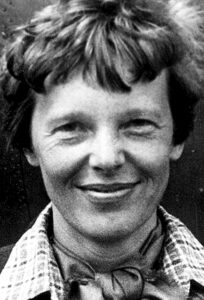HISTORICAL SOCIETY WINS RECOGNITION
Earhart Visited Here, Marker Says
By CHRYSTAL SAVAGE • Special to www.AllOTSEGO.com

After losing his mother to appendicitis in the spring of 1921 at age 7, Arrie Hecox of Fly Creek found solace in Amelia Earhart three years later.
Walking back and forth to school, Hecox spotted Earhart, then in her 20s, at the inn that neighbored his family’s farm on Route 28.
“As you did in that time, they introduced themselves,” Arrie Hecox’s grandson, Michael Baker said.
In later years, Hecox told his story to newspaper columnist Jim Atwell, who included it in his 2004 book, “From Fly Creek: Celebrating Life in Leatherstocking Country.”
“What are you reading?” Hecox asked the young woman in a khaki shirt, jodhpurs and boot, who was seated under an apple tree.
“A book about airplanes,” she replied with a smile.
Earhart sojourn and what became the Famulare family’s farm in the 1940’s is about to be memorialized.

The Fly Creek Historical Society announced its application for a “Legends & Lore” marker has been approved by the Pomeroy Foundation, and will be erected later this year.
That’s the historical society’s sixth Legends & Lore marker. Sherlee Rathbone, society president, said that means the Town of Otsego, where Fly Creek is located, has more than any community in the state.
The others memorialize David Shipman, inspiration for James Fenimore Cooper’s Natty Bumppo, as well as Cattown Road, Honey Joe Road, Bed Bug Hill and Panther Mountain.
Mary Winne, who lives on nearby Johnston Road, is a Famulare and was raised in the white clapboard cape across 28 from Simple Integrity’s headquarters.
When her family moved into the house in the 1940s, the living room had been divided into three bedrooms, she said; her parents concluded it had been a rooming house.
It’s also thought, she continued, that Earhart, the first woman aviator to fly solo across the Atlantic Ocean, was friendly with aviators at an a airstrip in Frankfort, down in the Mohawk Valley, which kept her around for a while.
As Atwell related it, Hecox considered Earhart, who would disappear in 1937 trying to fly over the Pacific, the “first love of (his) life.”
“When my grandfather heard (Earhart) went missing, he said he felt it in his heart that she was gone from this world,” said Baker.


My husband and I have passed that historic marker several times during our stays with family here, but haven’t exactly been able to stop and read it in full. Thank you for explaining it and what a great historic reference!